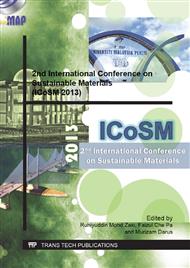[1]
Beukers, A. (1999). Lightness, the inevitable renaissance of minimum energy structures, Rotterdem: 010 Publishers, 72.
Google Scholar
[2]
Hogland, W., & Stenis, J. (2000). Assessment and system analysis of industrial waste management, Waste Management, 20, 537-543.
DOI: 10.1016/s0956-053x(00)00020-9
Google Scholar
[3]
El-Fadel, M., Zeinati, M., El-Jisr, K., Jamali, D. (2001). Industrial waste management in developing countries; the case of Lebanon, Journal of Enviromental Management, 61, 281-300.
DOI: 10.1006/jema.2000.0413
Google Scholar
[4]
Baradan, B. (1987). Fly ash cement based structural materials, International Journal of Cement Composites and Lightweight Concrete, 9(4), 225-228.
DOI: 10.1016/0262-5075(87)90005-4
Google Scholar
[5]
Kiattikomol, K., Jaturapitakkul, C., Songpiriyakij, S., & Chutubtim, S. (2001). A study of ground coarse fly ashes with different fineness from various sources as pozzolanic materials, Cement and Concrete Composites, 23(4), 335-343.
DOI: 10.1016/s0958-9465(01)00016-6
Google Scholar
[6]
Aggarwal, L. K. (1995). Bagasse-reinforced cement composites, Cement and Concrete Composites, 17(2), 107-112.
DOI: 10.1016/0958-9465(95)00008-z
Google Scholar
[7]
Ashori, A., Tabarsa, T., & Sepahvand, S. (2012). Cement-bonded composite boards made from poplar strands, Construction and Building Materials, 26, 131-134.
DOI: 10.1016/j.conbuildmat.2011.06.001
Google Scholar
[8]
Alida, A., Shamsul, J. B., Mazlee, M. N, & Kamarudin, K. (2011). Composite cement reinforced coconut fiber: Physical and mechanical properties and fracture behavior, Australian Journal of Basic and Applied Sciences, 5(7), 1228-1240.
Google Scholar
[9]
Lange, D. A., Ouyang, C., & Shah, S. P. (1996). Behavior of cement based matrices reinforced by randomly dispersed microfibers, Advanced Cement Based Material 3, 20-30.
DOI: 10.1016/s1065-7355(96)90066-8
Google Scholar
[10]
Mansur, M. A., & Aziz, M. A. (1983). Study of bamboo-mesh reinforced cement composites, The International Journal Of Cement Composites and Lightweight Concrete, 5(3), 1-7.
DOI: 10.1016/0262-5075(83)90003-9
Google Scholar


